“A crowd of people, workers, clerks and managers walk quickly at the streets
of Napoli, of Messene, of Syracuse and Tarant. Computers control the flow
of the economy and in the city harbours ocean liners and oil tankers of a
thousand tons moor, while from their airports many airplanes take off, with
hundreds of passengers.
The hasty visitor of our era cannot perhaps even think about that distant moment
in time when the coasts were still unpolluted, filled with rich forests; the
time when ships ready to fall apart would anchor after a long, tedious journey,
to unload groups of young soldiers who walked cautiously towards the deserted
beach, afraid that at any moment the dreadful outcry of the native soldiers attempting
to repel them would echo through the woods, depriving them once and for all of
the dream of a new country.
They carried a knife with them, from their old country and ashes from the holy
fire that had burned at the acropolis of their homeland, hoping that they would
be able to create new hearths, to build new homes where new, foreign wives would
live, taken by force or seduced with gifts and they would bear them children
with new, unspoiled blood in their veins.
Valerio Manfredi, The Western Greeks
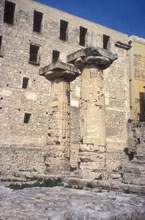 |
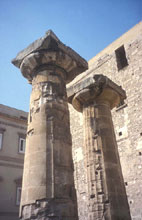 |
| The Doric temple of Taranto dedicated
to Poseidon(?), one of the few preserved monuments of the ancient
city, famous for its wealth and size. The two columns are situated
on the islet that was the acropolis of the city. |
| |
The Myceneans had settled in the Apulian region at the end of the second
millennium B.C. As the region was inhabited by the natives Messapians and
Iapyges, there was only one colony created, Taranto, the sole colony of the
Lacedaemonians (henceforth: Spartans). The Spartans preferred to extend their
territory by conquering their neighbours rather than emigrating. At the time
when the Eyboeans and the Corinthians travelled to the West in search of
new places for settlement, the Spartans fought against their Messinian neighbours
for almost 20 years in order to occupy their land (First Messinian War, 743-724
B.C.). The city of Taranto was founded in 706 B.C. by the Spartan Phalanthus
and the Parthenians.
Taranto collided with the natives Messapians and, even
though the Tarantians (or Tarentines) lost their first battles, they prevailed
and offered many offerings to the Oracle of Delphi (First quarter of the
5th century B.C.)
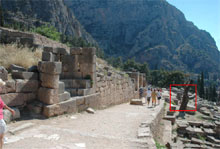 |
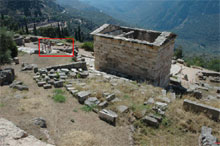 |
| Commemorating their victory over
the Messapians, the Tarantians, holding one tenth of their
loot, dedicated to Delphi, a monument of the sculptor Ageladas
that depicted captured women and horses. The monument dating
to the beginning of the 5th century (approximately 485 B.C.)
was in a prominent place, left of the Hiera Odos. Today, only
its base is preserved (red square). |
| |
Pausanias (10. 10.6-8) during his visit to Delphi in the 2
nd century
A.D. describes the historical course of the foundation of Taranto and the Tarantians’
monument of the Tarantians:
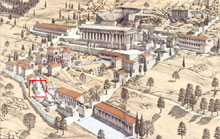 |
Reconstruction of Delphi and the location of the Tarantian
monument (red square)
© Delphi, Ekdotiki Athinon Publications |
The bronze horses and captive women dedicated by the Tarentines were made from
spoils taken from the Messapians, a non-Greek people bordering on the territory
of Tarentum, and are works of Ageladas the Argive. Tarentum is a colony of the
Lacedaemonians, and its founder was Phalanthus, a Spartan. On setting out to
found a colony, Phalanthus received an oracle from Delphi, declaring that when
he should feel rain under a cloudless sky (aethra), he would then win both a
territory and a city.
[7] At first, he neither examined the oracle himself nor informed one of his
interpreters, but came to Italy with his ships. But when, although he won victories
over the barbarians, he succeeded neither in taking a city nor in making himself
master of a territory, he called to mind the oracle, and thought that the god
had foretold an impossibility. For, never could rain fall from a clear and cloudless
sky. When he was in despair, his wife, who had accompanied him from home, among
other endearments placed her husband's head between her knees and began to pick
out the lice. And it chanced that the wife, such was her affection, wept as she
saw her husband's fortunes coming to nothing.
[8] As her tears fell in showers, and she wetted the head of Phalanthus, he realized
the meaning of the oracle, for his wife's name was Aethra. And so on that night
he took from the barbarians Tarentum, the largest and most prosperous city on
the coast. They say that Taras the hero was a son of Poseidon by a nymph of the
country, and that after this hero were named both the city and the river. For
the river, just like the city, is called Taras. [Translation by W.H.S. Jones,
Litt.D., and H.A. Ormerod, M.A.]
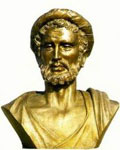 |
| Archytas |
The city of Taranto (Taras) was built on the cape that blocks the mouth
of the two lagoons. The city extended up to 570 hectares. At the end of
the 5
th century, democracy prevailed in Taranto which reached
its peak under the administration of the philosopher Archytas of Tarentum.
There were two famous statues of Hercules and Zeus at the city’s agora.
The statue of Zeus was the tallest statue of the Mediterranean world, reaching
a height of 18 meters. The wealth of the city had gradually led to the
decline of its power, and the Tarantians, who lived abundantly, would call
military troops from Sparta and Epirus to battle with their neighbors,
the Messapians and the Leukanians who were a constant threat.
During the conflicts with the Romans and the neighboring city of Thourioi, the
Tarantians called for the king of Epirus, Pyrros. He arrived, bringing some elephants
among other weapons, which terrorized the Romans who subsequently lost the first
battles; they soon regrouped and prevailed, while Pyrros, fled to Epirus. The
final destruction of the city took place in 209 B.C. when the Tarantians attempted
to recover the administration of their city with the alliance they made with
the Carthaginians. The Romans took over Taranto and looted the city, transporting
a large part of the loot to Rome, including the famous, tall statue of Hercules.
This statue was transported to Istanbul and during the occupation of the Francs
in 1204 it was melt in order to become coins.
In the centuries that followed, the city of Taranto was in decline; it also had
to survive pirate attacks, who forced the inhabitants of the city to withdraw
to the interior of the country. The revival of the city’s port started during
the short period of the French occupation at the beginning of the 19
th century.
 |
| Mare Picollo and the islet of the acropolis
of ancient Taras. The bridge connects the city with the islet
and leads to the open bay of Taras (Mare Grande) |
| |
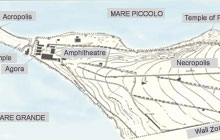 |
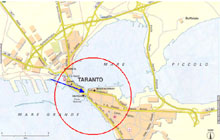 |
| Ancient Taras (picture © by Valerio M. Manfredi,
Greeks of the West). The dotted line shows the boundaries of the
city’s walls. |
The city of Taranto today. The Little Sea (Mare
Piccolo) proved to be an important incentive for the settlement of
the Spartans, since the bay of Taranto is generally harbourless.
The red circle defines the boundaries of the ancient city, buried
under the contemporary one. The blue arrow points out the position
of the Doric temple from which only two columns are preserved. |
| |
Strabo has an extensive description of the area of modern Apulia,
inhabited by the Messapians and by the Iapyges in the north, as well
as of the city
of Taranto. He also describes the founding of the city of Taranto by Phalanthus
and the Parthenians extensively; he uses the words of the historian Ephorus
who lived in the 4
th century B.C. but only a few excerpts of his
work are saved.
Strabo was born in a wealthy family from Amaseia
in Pontus. His mother was Georgian. He studied under various geographers
and philosophers; first in Nysa, later in Rome. He was philosophically
a Stoic and politically a proponent of Roman imperialism. Later he
made extensive travels to Egypt and Kush, among others. It is not known
when his Geography was written, though comments within the work itself
place the finished version within the reign of Emperor Tiberius. Some
place its first drafts around AD 7, others around 18.
Several different dates have been proposed for Strabo's death, but most
of them place it shortly after 23.
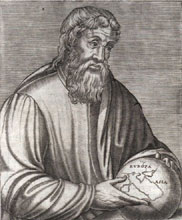 |
| The Greek geographer Strabo in
a 16th century engraving. |
|
Strabo,
Geography, 6.3. “Now that I have traversed the regions of Old
Italy as far as Metapontium, I must speak of those that border on them. And Iapygia
borders on them. The Greeks call it Messapia also, but the natives, dividing
it into two parts, call one part (that about the Iapygian Cape) the country of
the Salentini, and the other the country of the Calabri. Above these latter,
on the north, are the Peucetii and also those people who in the Greek language
are called Daunii, but the natives give the name Apulia to the whole country
that comes after that of the Calabri, though some of them, particularly the Peucetii,
are called Poedicli also. Messapia forms a sort of peninsula, since it is enclosed
by the isthmus that extends from Brentesium as far as Taras, three hundred and
ten stadia. And the voyage thither around the Iapygian Cape is, all told, about
four hundred stadia. The distance from Metapontium is about two hundred and twenty
stadia, and the voyage to it is towards the rising sun. But though the whole
Tarantine Gulf, generally speaking, is harborless, yet at the city there is a
very large and beautiful harbor, which is enclosed by a large bridge and is one
hundred stadia in circumference. In that part of the harbor which lies towards
the innermost recess, the harbor with the outer sea, forms an isthmus, and therefore
the city is situated on a peninsula; and since the neck of land is low-lying,
the ships are easily hauled overland from either side. The ground of the city,
too, is low-lying, but still it is slightly elevated where the acropolis is.
The old wall has a large circuit, but at the present time the greater part of
the city—the part that is near the isthmus—has been forsaken, but the part that
is near the mouth of the harbor, where the acropolis is, still endures and makes
up a city of noteworthy size. And it has a very beautiful gymnasium, and also
a spacious market-place, in which is situated the bronze colossus of Zeus, the
largest in the world except the one that belongs to the Rhodians. Between the
marketplace and the mouth of the harbor is the acropolis, which has but few remnants
of the dedicated objects that, in early times, adorned it, for most of them were
either destroyed by the Carthaginians, when they took the city, or carried off
as booty by the Romans, when they took the place by storm. Among this booty is
the Heracles in the Capitol, a colossal bronze statue, the work of Lysippus,
dedicated by Maximus Fabius, who captured the city.
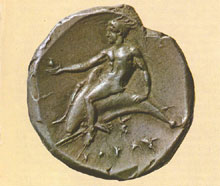 |
| Coin (stater) of Taranto, 4th century B.C. The mythical
colonist Taras is depicted on a dolphin. According to the myth, Taras
was the son of Poseidon and of a local nymph, Satyria. |
In speaking of the founding of Taras, Antiochus says: After the Messenian war
broke out, those of the Lacedaemonians, who did not take part in the expedition,
were adjudged slaves and were named Helots, and all children who were born in
the time of the expedition, were called Partheniae and judicially deprived of
the rights of citizenship, but they would not tolerate this, and since they were
numerous, formed a plot against the free citizens; and when the latter learned
of the plot they sent secretly certain men who, through a pretence of friendship,
were to report what manner of plot it was; among these was Phalanthus, who was
reputed to be their champion, but he was not pleased, in general, with those
who had been named to take part in the council. It was agreed, however, that
the attack should be made at the Hyacinthian festival in the Amyclaeum when the
games were being celebrated, at the moment when Phalanthus should put on his
leather cap (the free citizens were recognizable by their hair); but when Phalanthus
and his men had secretly reported the agreement, and when the games were in progress,
the herald came forward and forbade Phalanthus to put on a leather cap; and when
the plotters perceived that the plot had been revealed, some of them began to
run away and others to beg for mercy; but they were bidden to be of good cheer
and were given over to custody; Phalanthus, however, was sent to the temple of
the god to consult with reference to founding a colony; and the god responded, "I
give to thee Satyrium
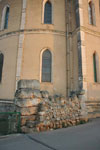 |
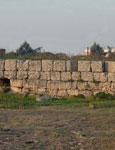 |
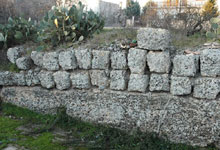 |
| The walls of the city of Mandyrion (Manduria).
Mandyrion was the eastern boundary of the Tarantian prevalence. The city
was protected by a triple row of walls. Under these walls, the king of
Sparta Archidamus was killed; he had come to the city from Sparta in 338
B.C. when the Tarantians requested his help. |
| |
(8) Satyrium was the cape of Italy, where contemporary Puglia (Apulia) is found.
For the march of Archidamus in Southern Italy, Diodorus Siculus states
(XVI, 63):
[..] At the same period,
9
the Tarantians were at war with the Leukanians and had sent their ancestors,
the Lacedaemonians, as ambassadors, seeking for military aid. The Spartans were
more than willing to assist, due to their kinship and have brought together in
a haste their navy and infantry and as their ruler they placed their own king,
Archidamus. As they were about to embark on Italy, the Lyctians
10 pleaded with
them, to go to their aid first. The Lacedaemonians were convinced and parted
for Crete, where they defeated the
mercenaries and restored the Lyctians to their own land again… Subsequently,
Archidamus set sail for Italy, where he joined forces with the Tarantians, but,
alas, died in a battle, after a brave fight
11. He was a
man of great praise for his strategic qualities and for his life in general,
who had only been dispraised for being in league with the Phoceans, as the one
begetting the capture of Delphi. Archidamus was king of Lacedaemonians for twenty
- three years.
(9) In 338 B.C., the battle of Chaironeia took also place; the Macedonians
of Philip and of Alexander the Great prevailed over the coalition of the
Greeks of Southern Greece.
(10) Lyctos: city of Crete conquered by the Phocaean Phalaikos.
(11) Plutarch in the Life of the Spartan king Agis, who succeeded Archidamus
(360-338 B.C.), mentions that the death of Archidamus occurred at the city of
Mandyrion.
The ancient city of Taranto has been covered up by the modern city, but the excavations
in the city and the surrounding area, have brought to light unique findings which
clearly reflect the cultural and social standards of the city. The art in the
Apulian region has surpassed even the Greek standards, creating unique impressive
forms, with pioneering artistic creations. These findings are exhibited at the
Museum of the city of Taranto.
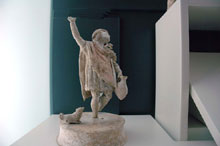 |
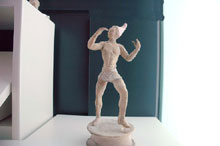 |
| Artifacts from the city of Taranto
and the Apulian region, exhibited at the Museum of Taranto. |
| |
Taranto was unable to extend to the east since the Messapians blocked their
prevalence. The city in an effort to preserve its interests, built a fortification
wall around the Gallipoli peninsula, at the entrance of the bay of Taranto.
The city, according to Pliny belonged to the Messapians and was called
Anxa. After its occupation by the Tarantians in 265 B.C., it was conquered
by the Romans, while in the centuries that followed in the Christian era,
the city shared the same fate with the rest of Apulia.
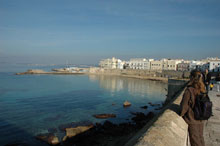 |
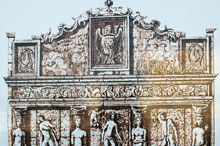 |
| The peninsula of Gallipoli at the entrance
of the bay of Taras (Taranto) was a colony of the Tarantians
in an effort to maintain control of the bay area. |
At the entrance of the peninsula, there
is an impressive fountain of the Hellenistic period. |
| |